Oil giants Shell, Santos, Woodside and Chevron finance the Bureau of Meteorology. Sandi Keane investigates the influence of the fossil fuel sector over the Bureau’s public documents.
The Bureau of Meteorology, the long-trusted national weather, climate and water agency, was established in 1906. It is tasked with “delivering products and services that contribute to the health, safety, wellbeing, social and economic lives of all Australians”.
One would expect, therefore, that tackling climate change is a key way of contributing to that health and wellbeing.
Freedom of Information documents have, however, revealed that gas giants such as Shell, Santos, Woodside and Chevron, some of the world’s biggest greenhouse gas emitters, are some of the Bureau’s biggest “customers”. In the 2018/2019 financial year, total revenue from these companies was $4.6 million.
That kind of money buys a lot of influence.
And earlier this year, the Bureau splashed a glowing article about Santos, a major player in gas fracking, across the internal website home page, leaked photos show.
“Bureau forecasts keep the oil and gas flowing from the Cooper Basin,” trumpeted the headline.
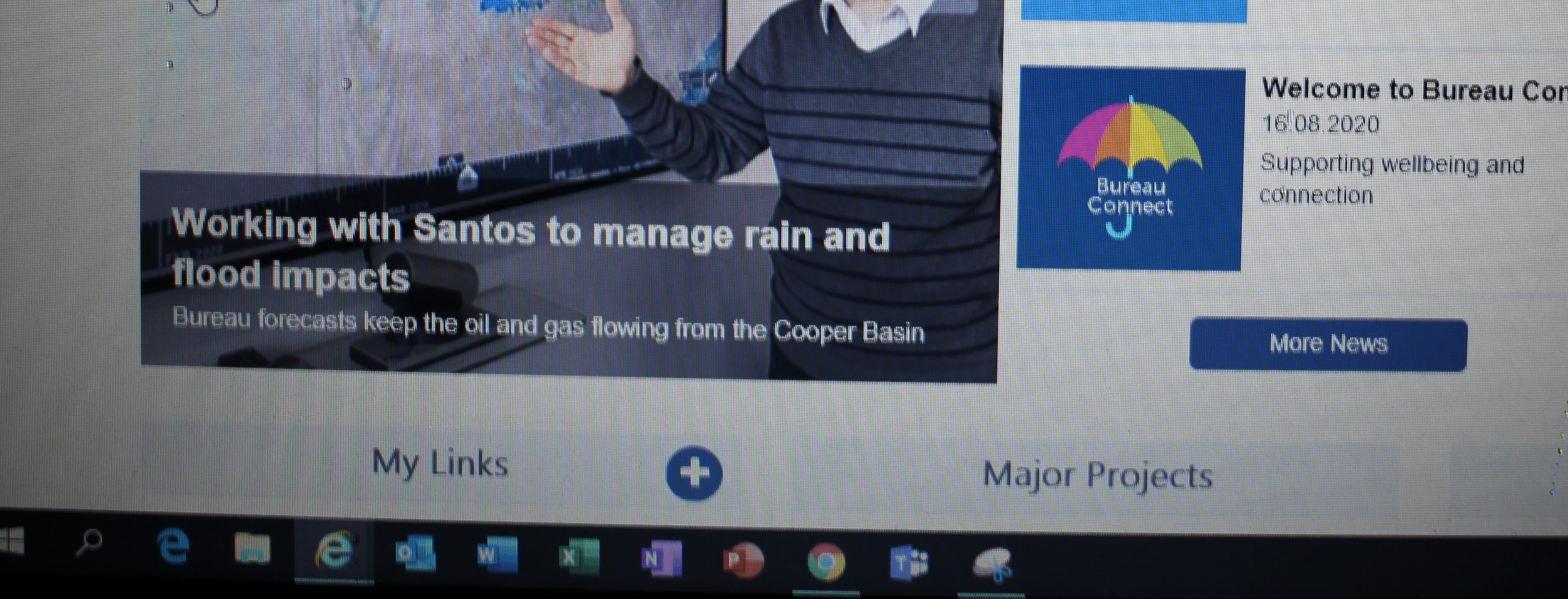
Recently, Michael West Media posed a question: Is the BoM under pressure to toe the Coalition party line? And the numerous documents released under FoI answer that question definitively.
In November 2019, just as the disastrous Black Summer was beginning to unfold, the Bureau produced a video “Bushfires and Exceptional heat: what’s driving our weather right now?”. A five-minute production, it explained all the drivers leading into the crisis; all except for one – climate change. We now know why that was excluded.
Before the video was released, the Bureau’s Public Affairs Manager wrote:
“This video is low risk and does not conflict with the CEO’s [Andrew Johnson] view the Bureau should not be proactively discussing climate context.”
Email from the Public Affairs Manager
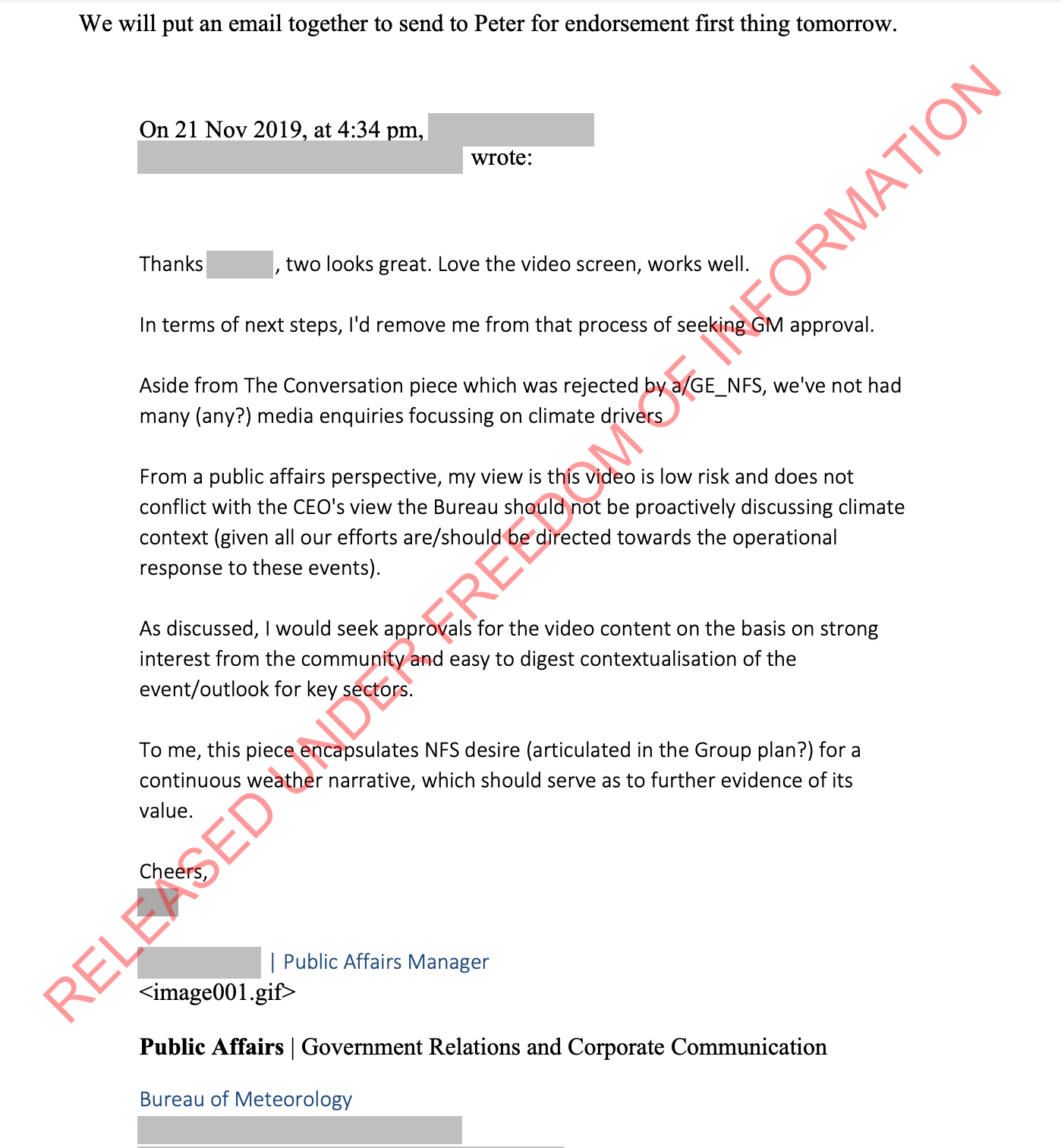
Extraordinary. The head of a national agency responsible for reporting on weather and climate believes the agency should not be proactively discussing the exact matters for which it is responsible.
The FoI documents also reveal staff discussions about how to seek the approval of the Chief Customer Officer, Peter Stone, to have the video published.
An early draft of the email among staff
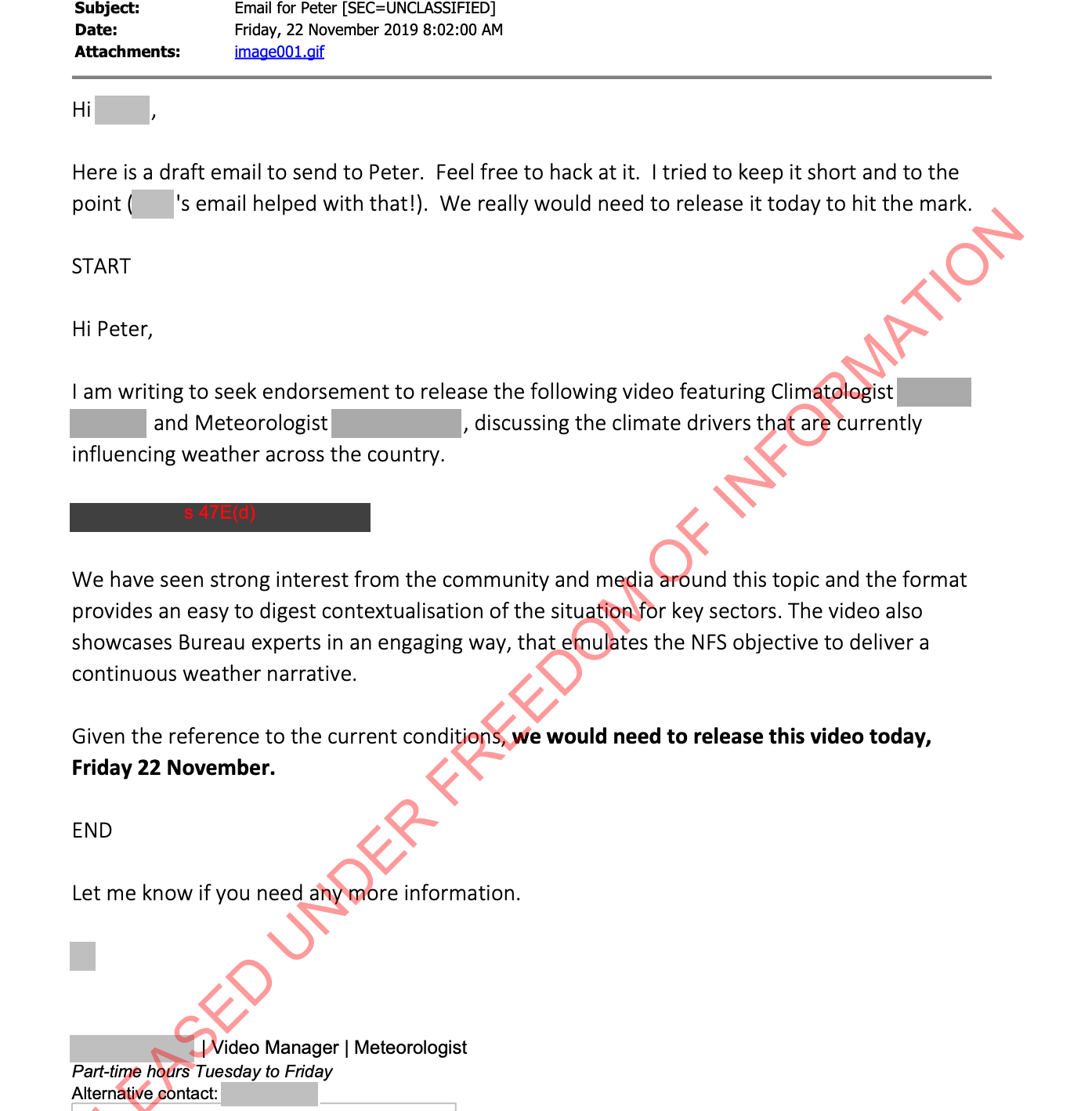
A later draft of the email among staff
After a few drafts, the following paragraph was included in the submission:
“I realise there are sensitivities around whether we discuss the climate in relation to recent weather conditions so we’d like to seek your endorsement to release this video today, Friday 22 November, on our social media channels.
This is not a video about climate change, but rather a focus on the current drivers to inform our customers.”
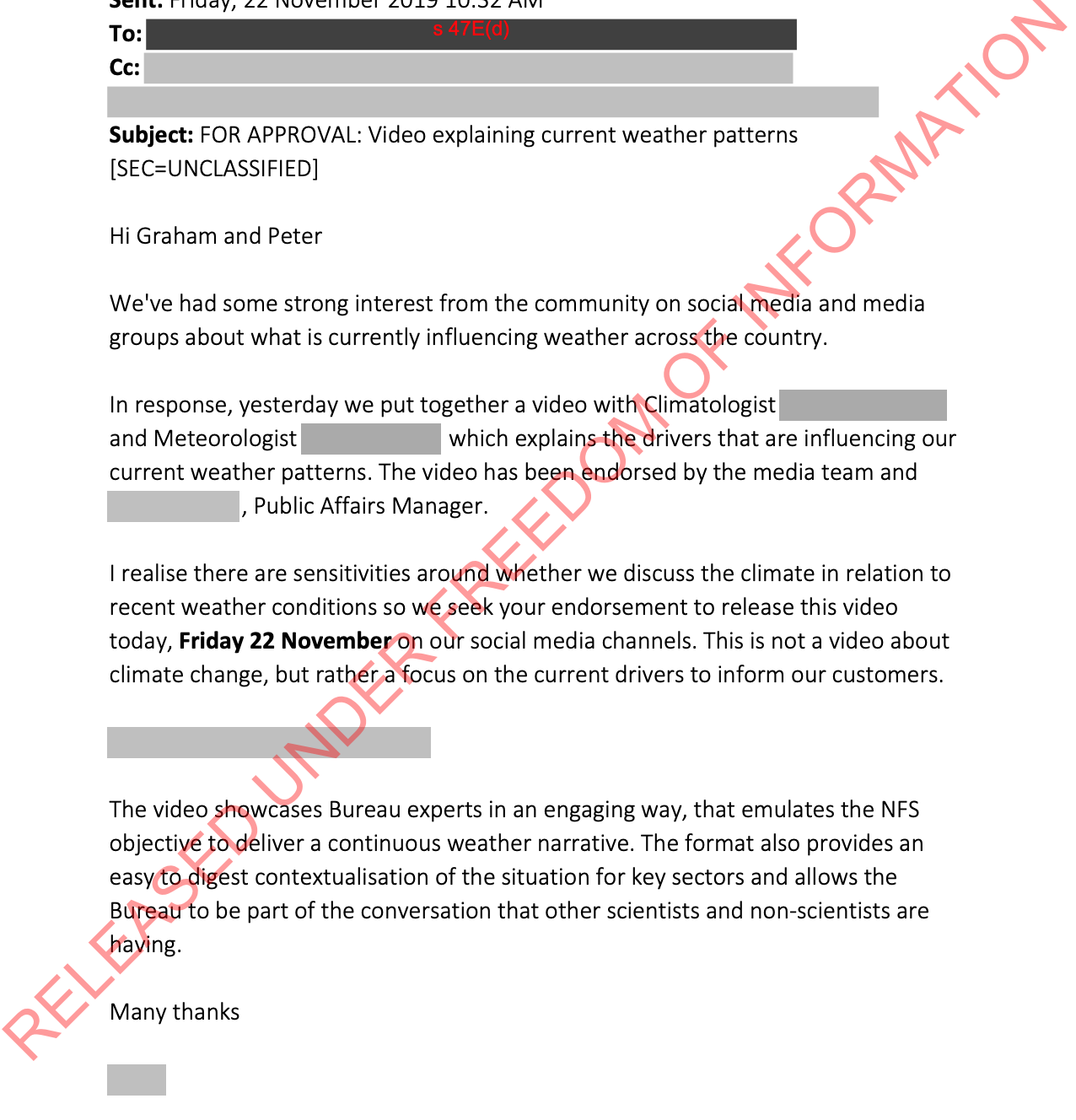
A month later, in December 2019, climatologists were working to put together a Special Climate Statement about the conditions leading to the bushfires.
The Bureau routinely produces such statements to document significant meteorological events that are unusual in the context of the climate for the affected region.
As the FoI document notes:
“The statements are an important historical record, provide analysis of broader historical and climatological context for events, and are used by other agencies including emergency services and health departments to inform their future planning.”
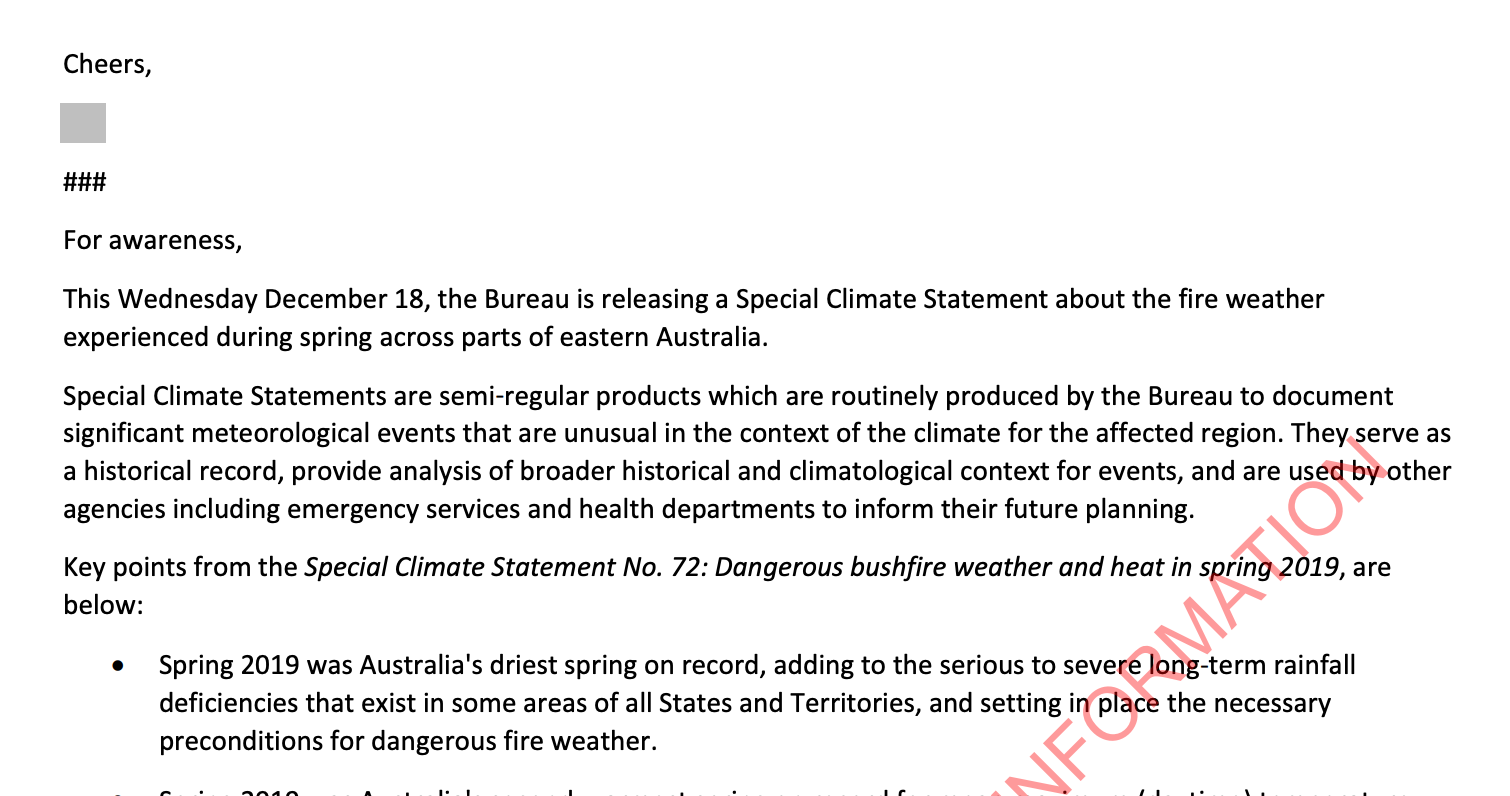
An early draft of the document goes into painstaking detail of all the meteorological and climatological conditions causing the bushfires. While the document had to be edited to ensure it could be understood by the general public, all references to climate change and long-term warming trends were removed. See the paragraph in red, below.
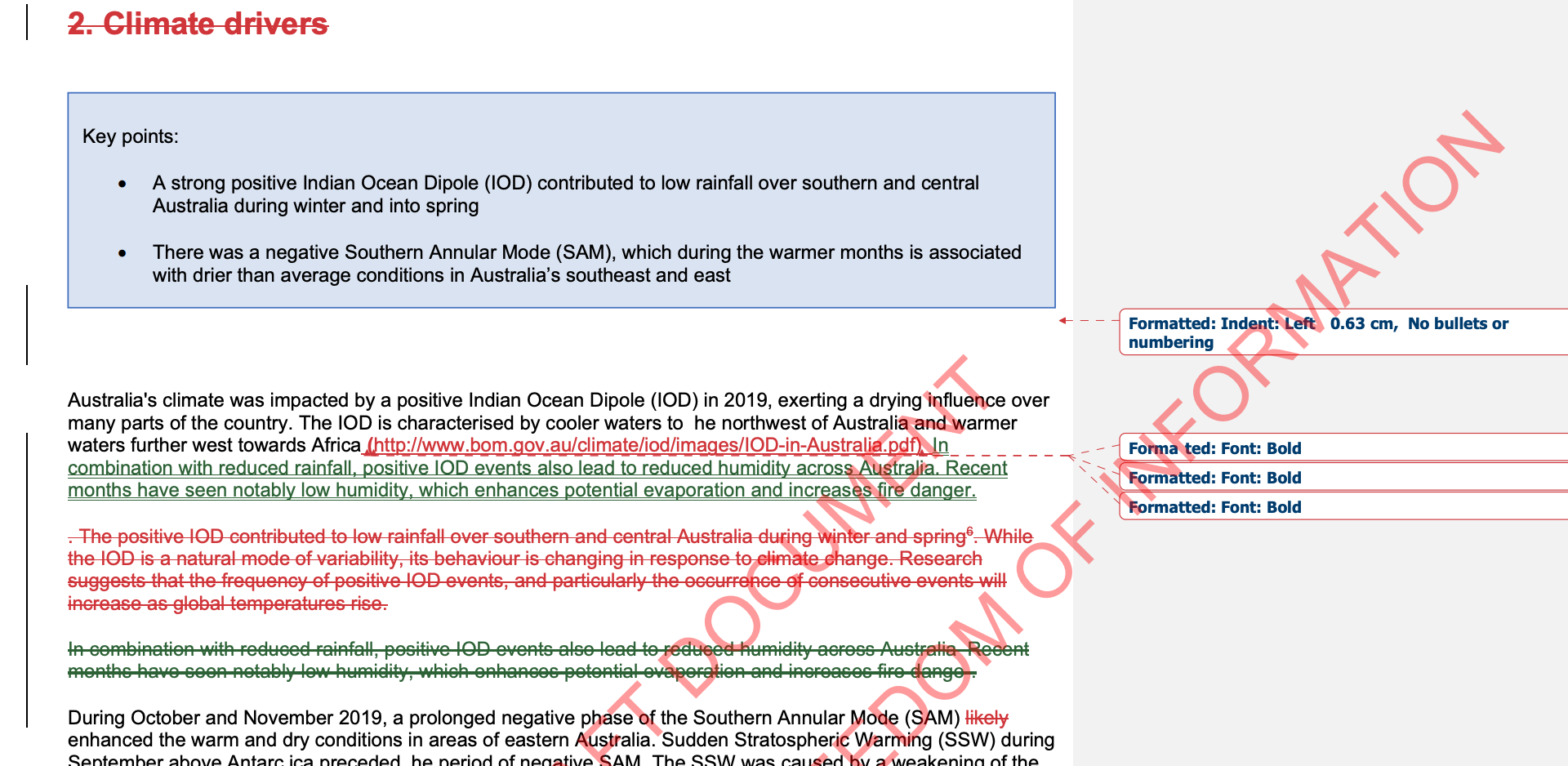
Public affairs manager did not want the special climate statement actively promoted – see link here.
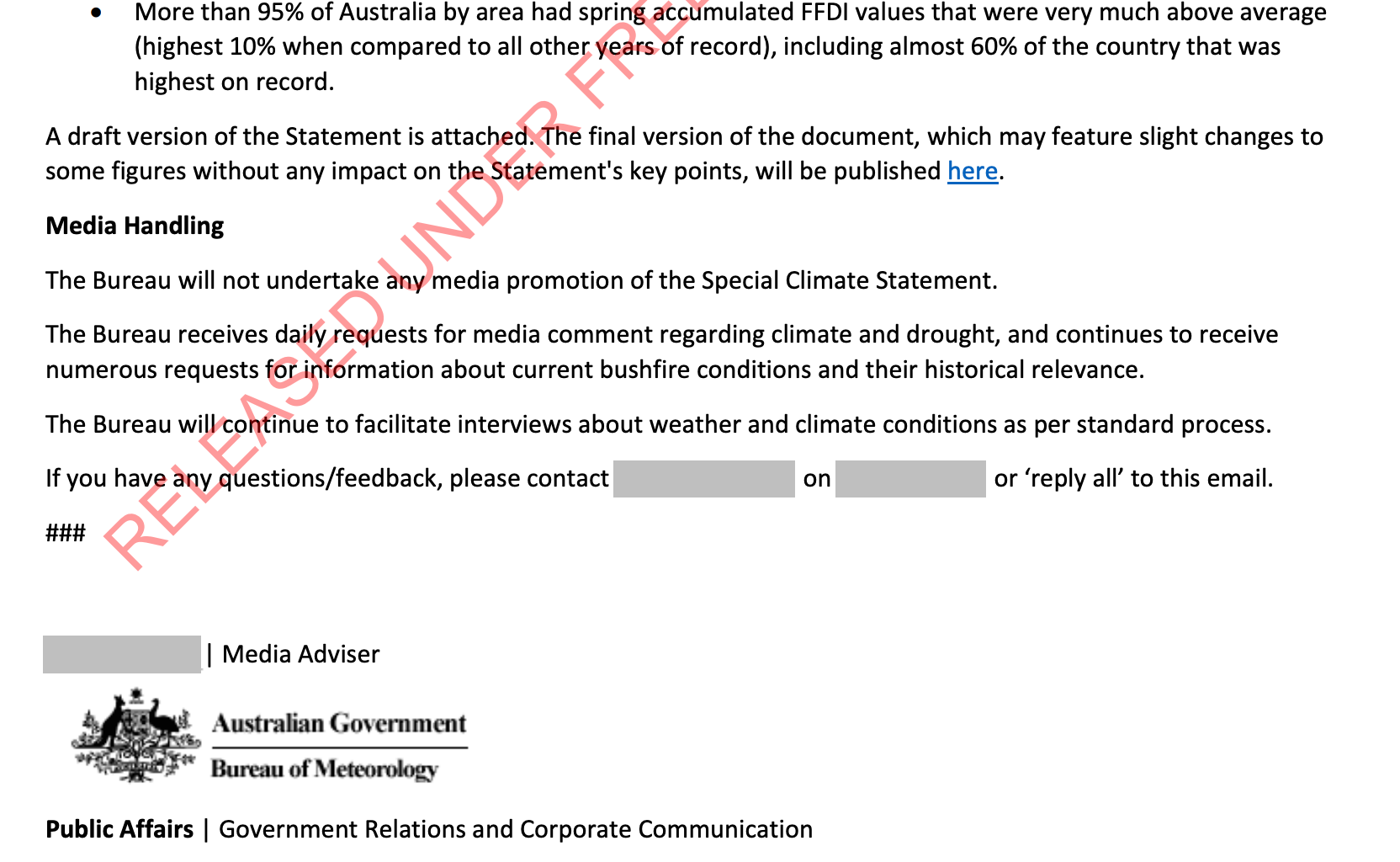
Graph of huge rise warming deleted
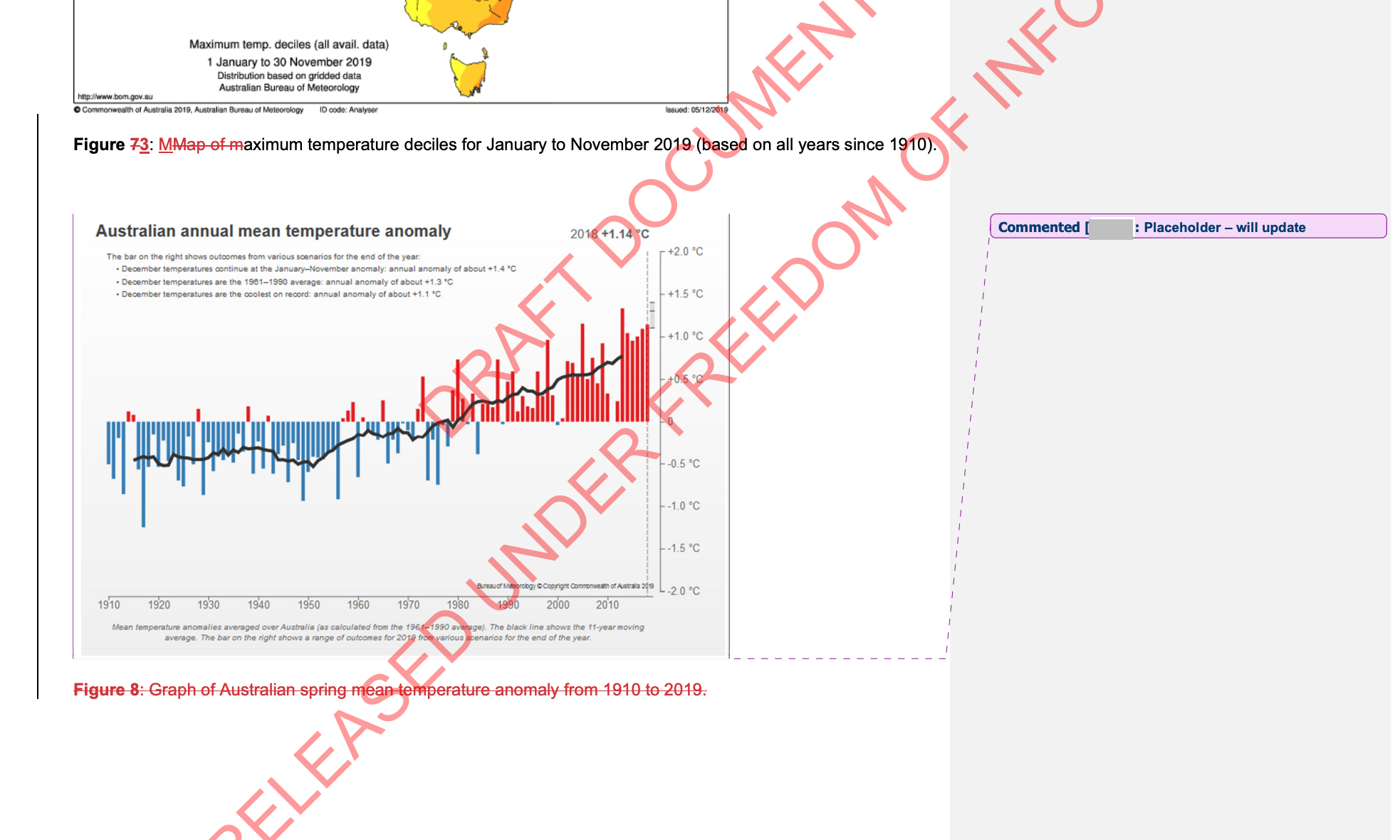
Information on longer fire season deleted
Edits made to meet customer needs
Chief Customer Officer Peter Stone, the founder of the Gas Industry Social and Economic Research Alliance (GISERA), wrote that the edits were made “to even more fully meet customer needs”.
To translate this corporate speak: “the gas industry doesn’t want us talking about climate change, especially not as the cause of these fires.” See link here.
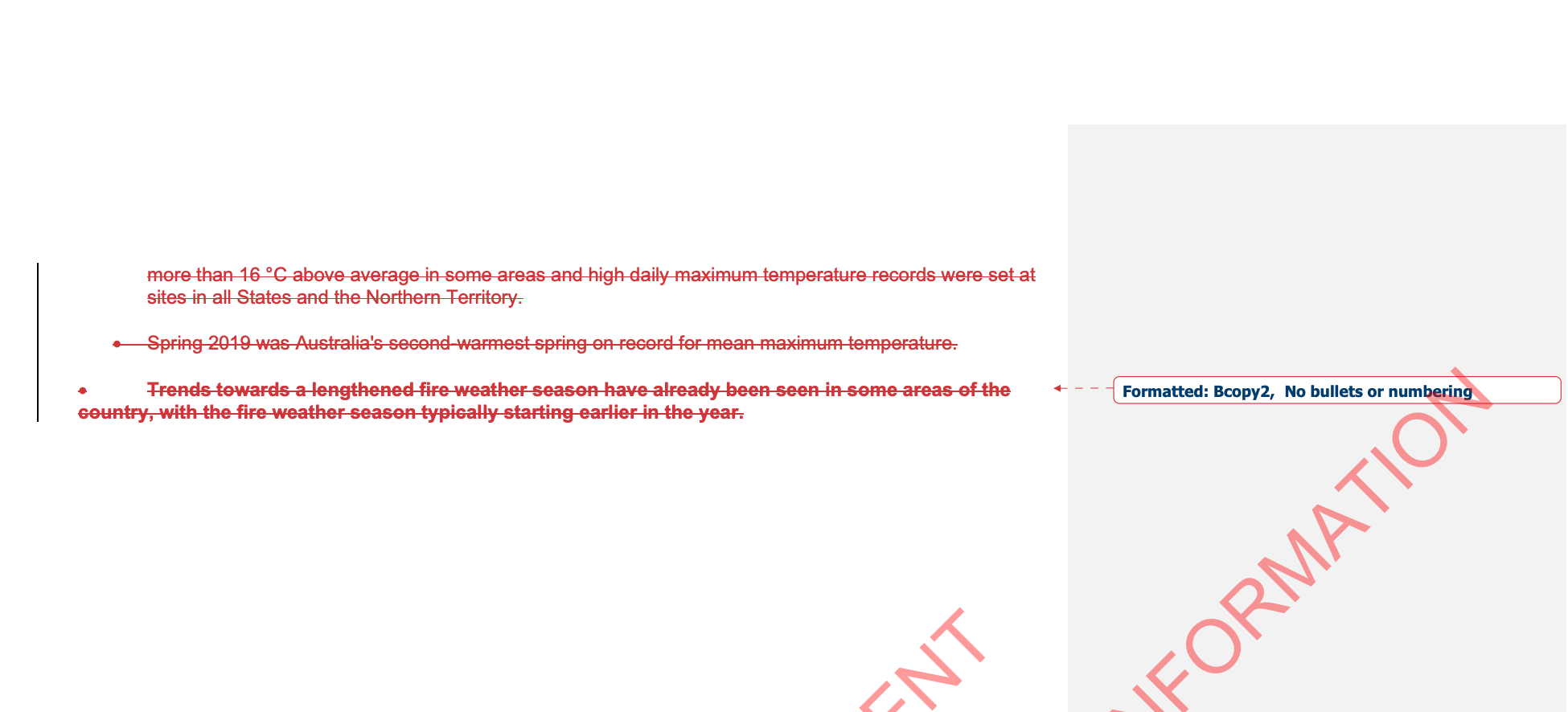
For years, climate deniers and fossil fuel lobbyists have attacked the Bureau for adjusting temperature records to exaggerate the effects of climate change. Upon his retirement as the BoM’s director in 2016, Rob Vertessy, hit back at ‘time wasters’ and ‘amateurs’ who are given a forum by The Australian.
The irony is that the BoM does have a record of doctoring climate statements but it is actually to downplay the effects of climate change to please its bosses, who have close ties to the gas industry.
Bureau of Meteorology: under pressure to toe the Coalition line on climate change?
Under the leadership of chief executive Andrew Johnson, climate research has come to a grinding halt. In response to our first article, the Bureau said: “Attributing individual events to climate change is the subject of ongoing research by many organisations, including the Bureau of Meteorology.”
However the last research report published by the BoM that relates to climate attribution science was done in 2016, more than four years ago, before Johnson’s arrival.
That report studied the October 2014 and 2015 heatwaves. It also made a quantifiable link between the heatwaves and the warming Australia had experienced. The report said “that the last 55 years of CO2 warming contributed roughly 1°C to the extreme heat forecast across Australia in both events”. Other factors contributed a further 1°C to the event.
Not a single study has been produced since this one. Nor has any portion of the Black Summer been attributed to climate change. All of BoM’s research reports are available here.
At Senate Estimates when asked how much climate change contributed to the fires, Johnson answered:
“I wouldn’t want to speculate on that. I’m not sure it’s even possible to apportion components.”
Nearly one year after the devastating fire season, this research still has not been done.
Thankfully, our trusted scientists haven’t been entirely gagged as the State of the Climate 2020 report shows.
However, if you look carefully enough, you can see the influence of the gas industry. While the report correctly points out increasing CO2 levels correlated with increase in average temperature, it stops short of recommending that Australia reduces its exports and burning of fossil fuels.
The BoM continues to trot out the tired old line that a single event cannot be attributed to climate change – what is called climate attribution science – yet this relatively new science has come a long way.
While the Bureau sits idle in the field of climate attribution science, others have been hard at work agencies such as the UK Met Office Hadley Centre.
In May this year, Peter Stott, a professor and expert on climate attribution science at the Hadley Centre said:
“We are seeing an unprecedented climate. The human fingerprint is everywhere.”
In 2016, Professor David Karoly, an internationally recognised expert on climate change and climate variability, presented a lecture at the ARC Centre of Excellence for Climate System Science on the “Statistical aspects in the estimation of the anthropogenic contribution to observed climate change”. This was based on earlier work by the US National Academy of Sciences.
Similarly, in 2020 the World Weather Attibution said that the 2020 Siberian heatwave was almost impossible without climate change and that the observed fire weather index in Australia in 2019 “was exceptional with a probability of about 3% in any given year in the current climate to occur”.
Again, the Bureau of Meteorology stifles any relevant research and misleads the Senate as to the current state of the science.
Instead, the Bureau calls on the likes of Mike Utsler, a 40-year veteran of the oil and gas industry, as a motivational guest speaker for the Bureau’s June 2018 ‘Strategy in Action’ event. Utsler has worked for Woodside Petroleum and was a major player in the BP Deepwater Horizon disaster.
While the Bureau clearly wants to keep its oil and gas customers onside, it has a much bigger customer, the Australian taxpayers, who provide its annual $263.3 million government appropriation, as noted in the 2019/20 annual report.
But are taxpayers getting any bang for their bucks when it comes to seriously tackling climate change. For Australia to have any hope of even setting appropriate targets for tackling climate change, it needs independent and accurate science.
This is impossible when its lead agency on meteorology and climate is headed by people with close ties to the fossil fuel industry who put customers’ needs ahead of the public interest.
At the very least, Andrew Johnson and Peter Stone must be removed from the BoM so its scientists can continue their work without fear of censorship.
MW's former editor, Sandi was also editor at Independent Australia.
Sandi has conducted corporate investigations, principally into the CSG and media sectors. Sandi holds a Masters degree in Journalism from the University of Melbourne.

